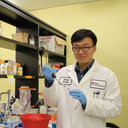[Clinical features and etiology of cholestasis in neonates].
Schlüsselwörter
Abstrakt
OBJECTIVE
To explore the clinical features and etiology of cholestasis in neonates, and elucidate the difference between preterm and term infants.
METHODS
A retrospective study was conducted for 176 cases of cholestasis during neonatal periods from January 2004 to December 2010 of Children's Hospital of Fudan University. Their etiologies included parenteral nutrition-associated cholestasis (PNAC), infection, biliary tract disorders, congenital abnormalities and chromosomal disorders, metabolic diseases, others (prenatal hypoxia, post unconjugated hyperbilirubinemia, neonatal lupus and congenital chylothorax) and unknown reasons. They were also divided into term and preterm groups according to gestational age, the relative factors, such as feeding patterns, use of parenteral nutrition (PN), infection and hypoxic history, and the clinical features, such as cholestasis onset age, bilirubin level, liver function and outcome were compared between two groups.
RESULTS
The time of fasting, age of starting feeding, age of reaching to full feeding and the time of overall PN time were all longer in the preterm group than those in the term group (all P < 0.01). The preterm group had more PN and infection cases (all P < 0.05). The term group presented earlier with cholestasis and liver function damage versus the preterm group (both P < 0.05). The rate of recovery in term group is lower than in preterm group which is (62.9% (22/35) vs 82.3% (116/141), P = 0.014). The etiologies of 35 term infants were infection (n = 11, 31.4%), biliary tract disorders (n = 4, 11.4%), congenital abnormalities and chromosomal disorders (n = 7, 20.0%), metabolic diseases (n = 3, 8.6%), others (n = 7, 20.0%) and unknown reasons (n = 3, 8.6%). There were 97 cases (68.8%) of PNAC in preterm infants and the average gestational age was 30(+4) (25(+3)-36(+2)) weeks. And the etiologies of the remaining 44 (31.2%) preterm cases without PNAC were infection (n = 21), biliary tract disorders (n = 3), metabolic diseases (n = 2), others (n = 5) and unknown reasons (n = 13).
CONCLUSIONS
The etiologies of neonatal cholestasis are diverse. It may be more complicated in term and non-PNAC preterm infants. It is important to screen cholestasis in neonatal inpatients. Basic etiological elucidation and long-term follow-up are necessary for the positive cases.





